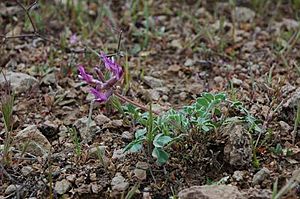Holmgren milk-vetch facts for kids
Quick facts for kids Holmgren milk-vetch |
|
|---|---|
 |
|
| Conservation status | |
| Scientific classification |
The Holmgren milkvetch (scientific name: Astragalus holmgreniorum) is a very rare plant. It's also called the paradox milkvetch. This special plant is a type of milkvetch, which is a group of plants in the pea family.
You can only find the Holmgren milkvetch in a small part of the desert. This area is right on the border between Utah and Arizona, in the northern Mojave Desert. There are only six groups of these plants left in the world. Because it's so rare, it's listed as an endangered species by the government. This means it's in danger of disappearing forever.
Contents
What Does the Holmgren Milkvetch Look Like?
This plant is a perennial herb. This means it lives for more than two years and doesn't have a woody stem like a tree. Instead, its leaves grow directly from the root crown, which is the part of the plant where the roots meet the stem.
The leaves can grow up to 13 centimeters long. Each leaf is made up of several smaller parts called leaflets. These leaflets are about 1.6 centimeters long.
Flowers and Fruits
The flowers of the Holmgren milkvetch grow in a cluster called a raceme. There are usually 6 to 16 flowers in each cluster. Each flower looks like a small pea flower and has a pretty purple color. The purple part of the flower, called the corolla, is about 2 centimeters long.
After the flowers bloom, the plant starts to grow its fruits. The stem that holds the flowers, called the peduncle, bends down. It lies on the ground as the fruits get bigger. Each fruit is a legume pod, just like a pea pod. These pods can be up to 5 centimeters long.
Why Is This Plant Endangered?
The Holmgren milkvetch faces several dangers that threaten its survival. These threats make it hard for the plant to grow and spread.
- Off-road vehicles: Vehicles like ATVs driving off roads can damage the plant's habitat. They can crush the plants or disturb the soil.
- Highway work: When roads are maintained or expanded, it can destroy the areas where these plants live.
- Power lines: Installing new power lines often involves clearing land. This can remove the plants and their natural home.
- Grazing animals: Animals like cattle or sheep eating the plants can also harm the populations.
- New plants: Sometimes, plants from other places are brought into the area. These "introduced species" can take over the space and resources that the Holmgren milkvetch needs to survive.
See also
 In Spanish: Astragalus holmgreniorum para niños
In Spanish: Astragalus holmgreniorum para niños


